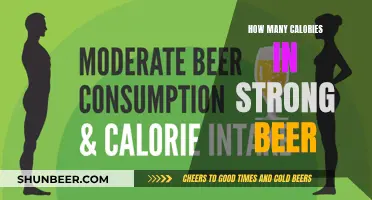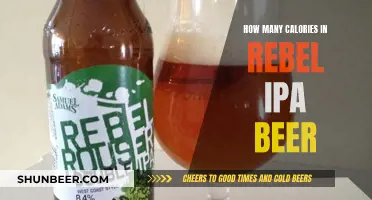
Beer is a popular drink worldwide, but it's important to be aware of its calorie and carbohydrate content, especially if you're watching your weight. The calorie content of beer varies depending on the style and brewer, with craft, seasonal, and high-alcohol beers tending to have more calories than lighter options. While beer doesn't contain fat, the calories can prevent our bodies from burning fat stores. Additionally, beer contains carbohydrates, and the more sugary the beer, the higher the carb content. So, how do you determine the calories and carbs in craft beers? You can use online resources, such as calorie calculators and nutritional information sites, to estimate the calorie and carb content of your favourite craft beer. These tools consider factors such as alcohol by weight, real extract, and alcohol by volume (ABV). By understanding the calorie and carb content of craft beers, you can make informed choices about your consumption and find a healthy balance.
What You'll Learn

Calories in craft beer come 60% from alcohol and 40% from carbohydrates
The calories in beer come mainly from carbs and alcohol. Craft beers, seasonal beers, and beers with high alcohol content tend to have more calories than lighter ones. Beer is typically higher in calories than wine or spirits.
Craft beer is derived from the natural starch in barley or other grains. This starch is fermented by yeast to give carbon dioxide and alcohol. During the fermentation process, the yeast breaks down the carbohydrates or sugar to create alcohol. The smaller chains of carbohydrates are broken down into alcohol, but the bigger ones remain in the beer as carbohydrates.
The calories in craft beer come 60% from alcohol and 40% from carbohydrates. So, a high-alcohol content beer will have more calories. The colour of a beer does not relate to its calorie content. The light colour of low-calorie beers is due to the low usage of grain in the brewing process. The moderate use of grain results in a low carbohydrate content in the alcohol, which in turn reduces the calories.
To determine the calories in beer, the alcohol by weight and the real extract (the extract remaining in beer after fermentation and containing carbohydrates, protein, and the mineral content of the beer) must be known. The mineral content can be obtained by drying down a known amount of beer and then subjecting it to high heat to burn off the organic constituents. The resulting ash is the mineral content of the beer.
In the United States, the calories expressed in 100 g of beer is then determined by the following formula: cal in 100 g of beer = 6.9 × alcohol % by weight + 4(RE – ash), with RE meaning the real extract (Plato) and ash expressed as a percentage by weight. The value 4 represents the 4 calories of energy per gram from protein and carbohydrate. If the value obtained from this calculation is multiplied by the specific gravity of the beer, the calories per 100 ml of beer is obtained. Finally, multiplying this number by 3.55 provides the caloric content of a 12 fl oz (standard US) serving size.
Lucky Streak Beer: Calorie Count for the Curious
You may want to see also

Higher alcohol content means higher calories
The calories in beer come from two main sources: alcohol and carbohydrates. Alcohol has a higher caloric value than carbohydrates, with 7 calories per gram for ethanol compared to 4 calories per gram for carbohydrates. Therefore, a beer with a higher alcohol content will generally have a higher number of calories.
The relationship between alcohol content and calories is not perfectly linear, as the specific gravity of the beer and other factors can also influence the total calorie count. However, as a general rule, higher alcohol content leads to higher calories.
Craft beers, seasonal beers, and beers with high alcohol content tend to have more calories than lighter beers. For example, a typical light beer might have an alcohol content of around 4-5%, while a craft beer could have an alcohol content of 6% or higher. This increase in alcohol content can lead to a significant increase in calories.
Additionally, the higher alcohol content in craft beers can also lead to increased appetite and food consumption, further contributing to the overall calorie intake.
When trying to determine the calorie content of a craft beer, it is important to consider both the alcohol content and the carbohydrate content, as both can significantly impact the total calorie count. Using a beer calories calculator or a beer ABV calculator can help provide a more accurate estimate of the calorie content.
In summary, when it comes to craft beers, higher alcohol content indeed means higher calories. This is due to the higher caloric value of alcohol compared to carbohydrates, as well as the potential for increased food consumption associated with higher alcohol intake.
Calorific Content of Beer Battered Cod Explained
You may want to see also

Dark beers tend to have more carbs than light beers
When it comes to beer, there are two distinct types: dark beer and light beer. While the appearance is the most noticeable difference, with almost all beers varying in colour, the nutritional content also differs between these two types.
Dark beers, such as porters and stouts, are made from barley malt that has been darkly roasted. The darker the malt, the darker the beer. These beers often have flavour notes of chocolate and toffee, produced by the roasting process. Dark beers usually have more ingredients, including barley, and added flavours such as coffee, chocolate, caramel, and nuts.
Light beers, on the other hand, use more hops and rarely, if ever, use added flavours. They tend to have a hoppy taste with citrus and floral notes. Light beers are also fruitier and more bitter than dark beers.
In terms of calories and carbs, light beers generally have fewer calories and carbohydrates than dark beers. Light beers typically have between 60 and 100 calories per bottle, while dark beers have around 200 calories per bottle. Light beers are a popular choice for those watching their calorie intake or who are sensitive to the high carbohydrate content of darker beers.
However, it is important to note that not all dark and light beers are created equal, and there can be exceptions to this general rule. The calorie and carb content of beer can vary depending on the type and amount of ingredients used, as well as the brewing process. For example, a "light" beer may have fewer calories than its regular counterpart, but it could still have more carbs. Additionally, some dark beers may have fewer calories than light beers, depending on the specific ingredients and brewing methods used.
Ultimately, the taste, calorie, and carb content of beer can vary widely, even within the categories of dark and light beers.
Calorie Count in Killian's Irish Red Beer Explained
You may want to see also

The more sugar your beer contains, the higher it will be in carbs
Beer is made from fermented grain, and its calories come mainly from carbs and alcohol. The more sugar your beer contains, the higher it will be in carbs.
Sugar is an essential element in brewing beer. It is not added as an ingredient but is derived from the processing of the grains and then fermented by yeast to produce alcohol. The main type of sugar in beer is maltose, which is made from two glucose molecules.
Beer gravity refers to the density of the wort (the liquid extracted from the mashing process) relative to water at various stages of fermentation. A wort with a high sugar concentration is called a high gravity wort. As yeast ferments the wort, its sugar content decreases while its alcohol content increases, resulting in a beer with a higher alcohol content.
The final sugar content of a beer depends on several factors, including its gravity, the type of yeast used, and any additional flavours included, such as honey or corn syrup.
While beer typically has a low sugar content, it is still a significant source of carbohydrates, which can affect blood sugar levels. Additionally, the alcohol content of beer also contributes to its calorie count.
The calorie content of beer can vary widely depending on its composition, from 15 calories/100 ml for low-alcohol beers to over 110 calories/100 ml for high-alcohol and high-residual-extract beers.
Craft beers, seasonal beers, and beers with high alcohol content tend to have more calories than lighter options. If you're watching your calorie intake, opt for alcohol-free or low-calorie beers, which typically have fewer calories.
Calorie Counting: IPA Beer Pints and Health
You may want to see also

Brewers don't usually list calorie content on their labels
Alcoholic drinks, including beer, are not regulated by the U.S. Food and Drug Administration (FDA). Instead, they fall under the purview of the Alcohol and Tobacco Tax and Trade Bureau (TTB). This separation of regulatory organisations dates back to a decision made in the 1930s, after the repeal of Prohibition. Consequently, alcohol has been exempt from listing serving facts since the FDA required modern nutritional labels on packaged food and beverages in 1990.
In 1993, the TTB considered amending its regulations to require nutrition facts on labels. However, the response was lacklustre, with only seven consumers submitting comments, most of whom opposed nutrition labelling. In 2003, another attempt was made to introduce nutrition labels, but manufacturers requested voluntary labels, arguing that putting nutrition facts on alcohol bottles would lead consumers to believe that alcohol was nutritious.
In 2004, the TTB issued guidelines allowing manufacturers to list calories, carbs, protein, and fat if they wished to. However, this was not mandatory, and most brewers chose not to disclose this information. This was likely due to concerns that consumers would cut down on their drinking, thereby reducing profits.
In 2014, the FDA announced a ruling that chain establishments with over 20 locations must list caloric information on their menus. This included alcoholic beverages. However, the ruling did not affect beer manufacturers, who were deemed "not affected" by FDA officials, leaving the onus on chain retailers to collect and display nutritional information.
In summary, the primary reason brewers don't typically list calorie content on their labels is due to the historical lack of regulatory requirements from the TTB, combined with the optional nature of nutritional labelling for alcoholic beverages.
Leinenkugel Beer Calories: How Many in Each Bottle?
You may want to see also
Frequently asked questions
The formula for calculating the calories in a beer is: Calories = ABV% x 2.5 x volume in ounces.
A 12-oz craft beer with 4.5% ABV contains approximately 135 calories.
Yes, craft beers contain carbohydrates. The more sugar in the beer, the higher the carb content.
It can be difficult to know the exact number of carbs in a craft beer without knowing the starting gravity before fermentation. However, a good rule of thumb is that thicker, sweeter beers tend to have more carbs.
Yes, there are some low-carb craft beer options available, such as Dogfish Head Slightly Mighty (95 calories and 3.6 grams of carbs per can) and Deschutes Da Shootz (99 calories and 4.2 grams of carbs per can).







